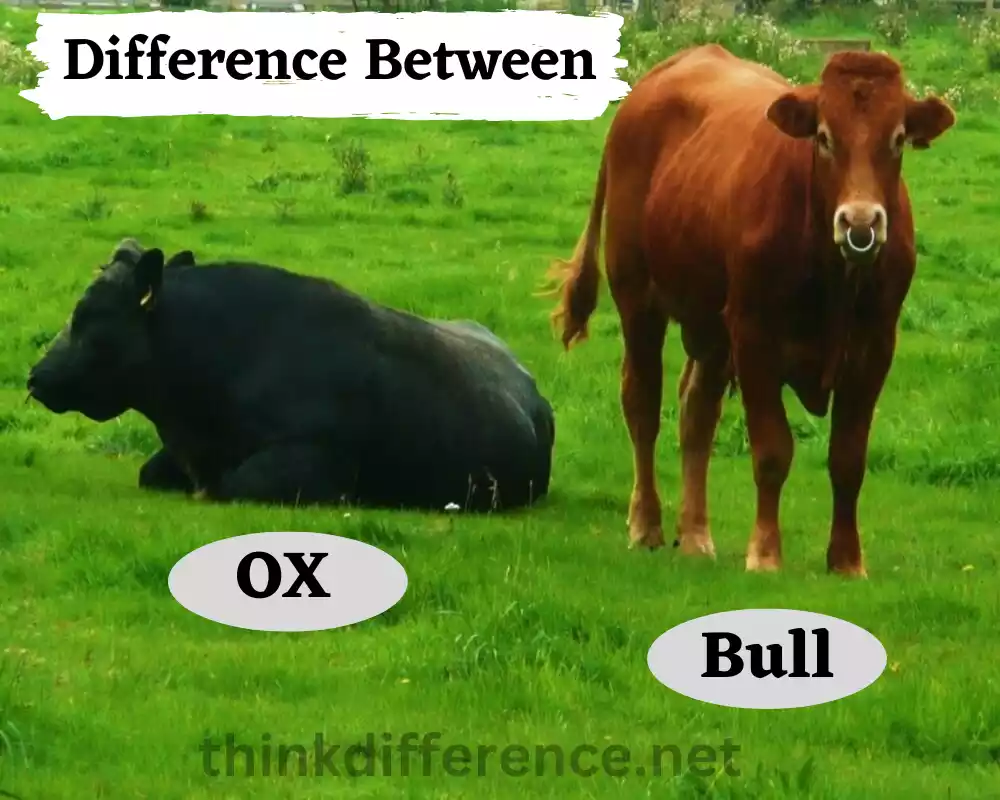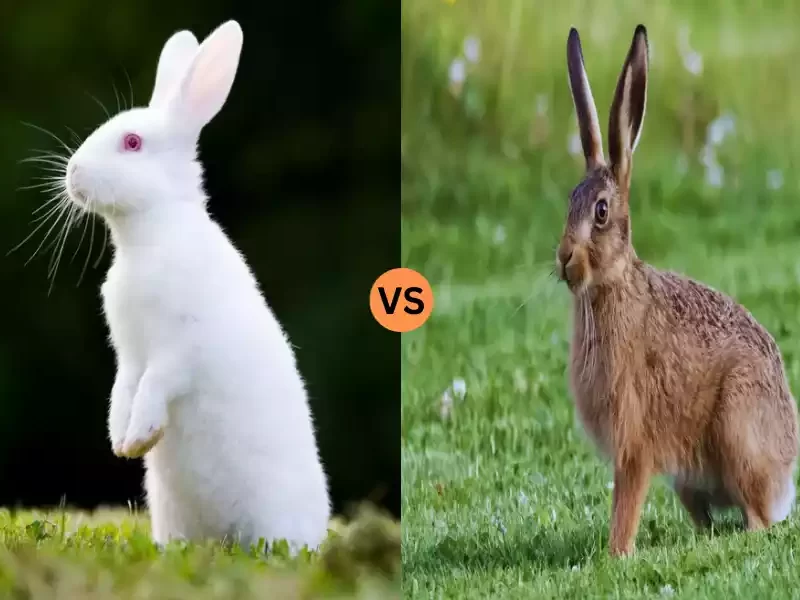Ox and Bull are revered animals across many cultures around the globe. Not only have they played a critical role in transport and agriculture, they are also symbols of strength, power and determination. Here we explore physical traits associated with bulls and oxen, compare traits between them, examine cultural significance of both species and highlight some fascinating qualities they share in common.
What is an Ox?
Ox is a domesticated bovine trained and utilized by humans for various tasks. An ox is defined as an animal that has been castrated by male bull (bull), specifically trained for draft work by castration – the act of extracting testicles so as to provide more comfort during working conditions and improve performance.
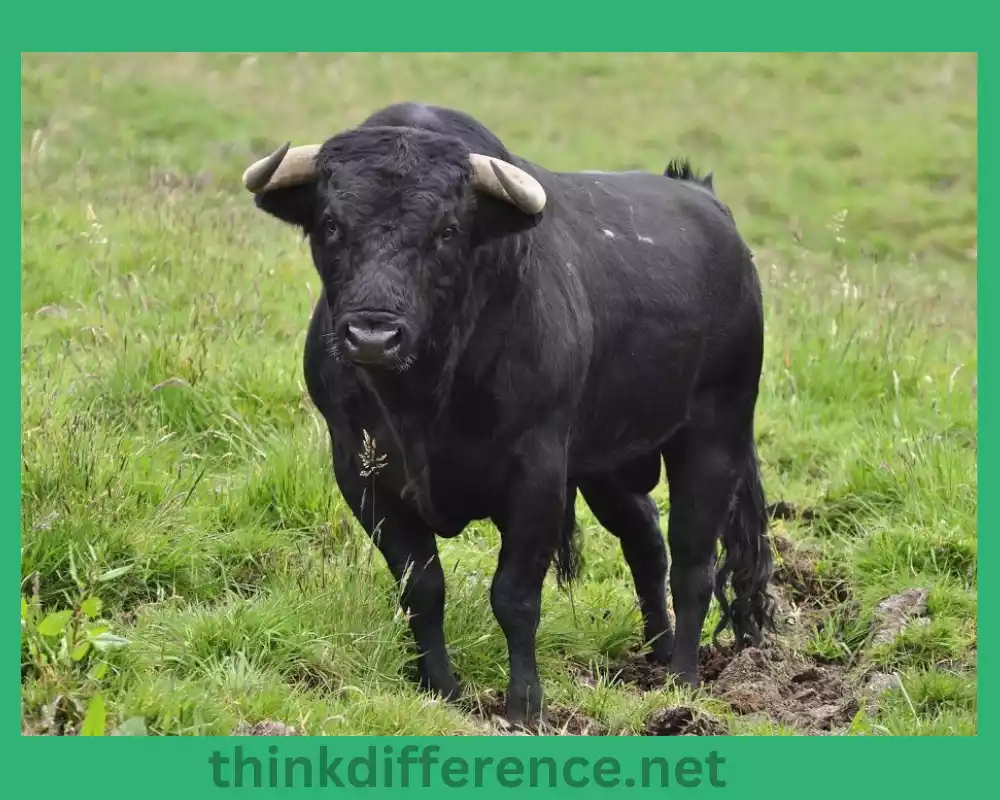
Oxen have long been used by humans for transportation and agriculture purposes, both transportation and farming practices alike. Renowned for their endurance, strength and the ability to carry large loads. Oxen are frequently utilized for plowing fields or hauling vehicles as powering machinery in traditional and rural farming techniques – they’re highly respected due to their dependability and constant speed!
Oxen are typically castrated male cattle “ox” can also refer to any bovine trained for draft work regardless of gender or reproductive status; although its primary meaning refers to castrated males.
Oxen are well known for their quiet and gentle temperaments that make them easier to train and handle compared to bulls. Their hard lives result in them growing larger and stronger than most cattle breeds; their distinctive wooden neck yokes allow them to efficiently pull weights.
Oxen have played an invaluable role in different societies throughout history and provided essential services like transportation and agriculture that greatly benefit humans.
What is a Bull?
Bulls are bovine animals belonging to the cattle breed known as Bovidae that remain non-castrated adult males throughout life. Bulls are widely recognized for their muscle construction, strength and aggressive nature at certain points during their lives.
Bulls are widely utilized as breeding animals within animal husbandry. Their main function in keeping is mating with cattle (female calves) and producing offspring; with fully functional reproductive organs and hormones that allow natural mating behaviors. As part of population expansion they contribute greatly.
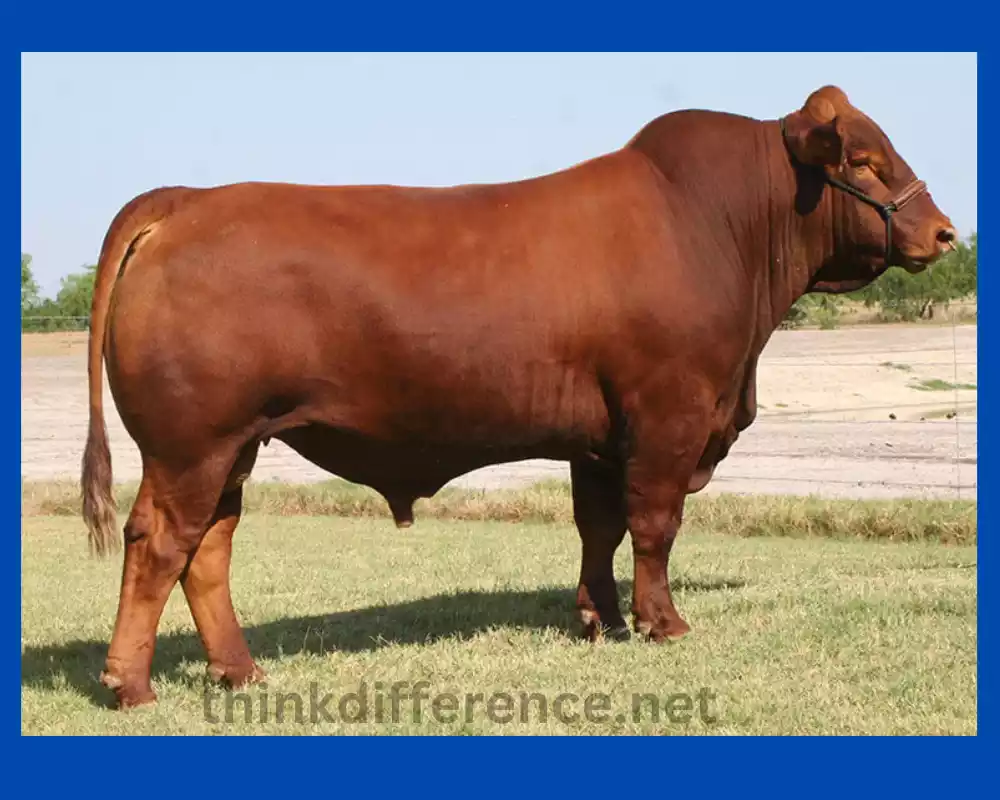
Apart from their function as breeders, bulls also hold great significance within society’s cultures and economies. Considered symbols of power, virility and strength they often form part of religious rituals around the globe. In some religions worshipping bulls is part of religion traditions dating back centuries ago.
Bulls have long been used as performers and participants in traditional sporting and events such as bullfighting rodeo and bull riding to demonstrate both physical strength and agility while providing entertainment to viewers. These activities show off these animals while showing them at their finest!
Physically speaking, bulls tend to be bigger and stronger than both cows (adult female cattle) and Oxen (castrated male cattle), featuring large, distinctive horns of various sizes depending on breed type. Bulls also possess an aggressive nature when breeding season arrives or protecting territories and herd.
Keep in mind that bulls can be extremely dangerous creatures that require expert handlers in order to be handled responsibly and safely. Their aggressive behaviour could present potential threats both to people as well as animals if not managed appropriately.
Importance of understanding the differences between an Ox and a bull
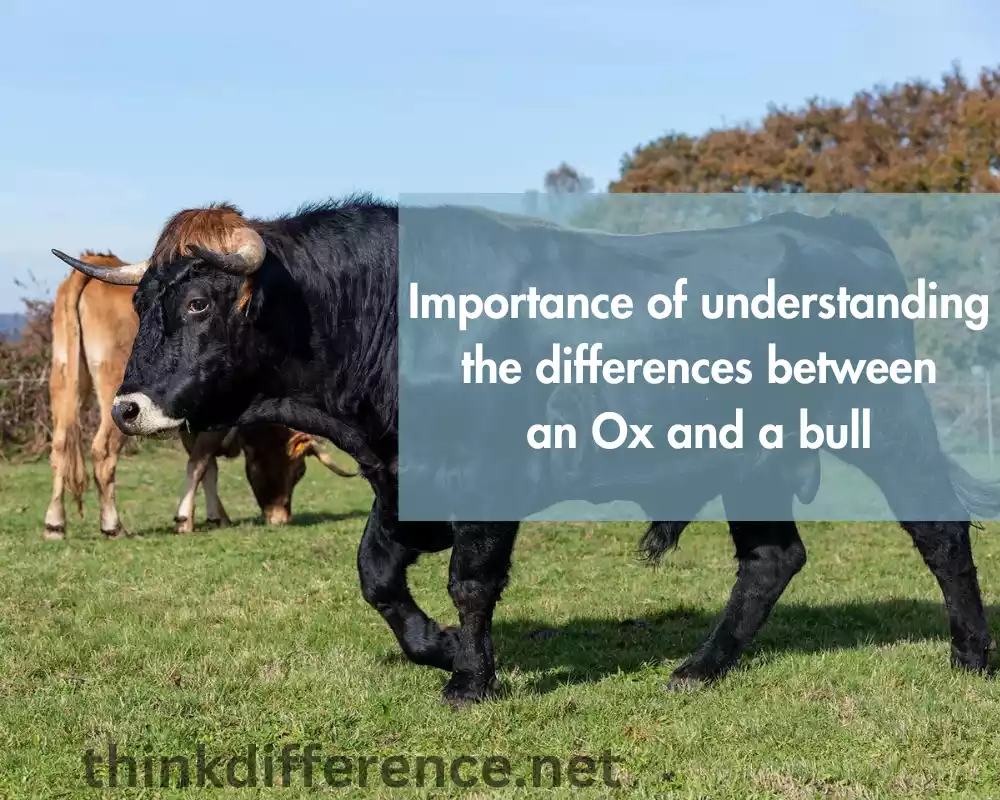
Understanding the differences between an ox and a bull is important for several reasons:
- Practical Purposes: Knowing the distinctions helps in selecting the right animal for specific tasks. Oxen are trained and used for draft work, such as plowing fields or pulling heavy loads, due to their docile nature and suitability for working. Bulls are primarily used for breeding purposes. Understanding their respective roles allows farmers and handlers to make informed decisions regarding the appropriate animal for their intended purpose.
- Safety and Handling: Bulls, being intact males with natural aggressive tendencies, require different handling techniques compared to oxen. Understanding the behavioral differences between the two can help ensure the safety of handlers and other livestock. Proper handling techniques and precautions are essential when working with bulls to minimize the risk of accidents and injuries.
- Animal Welfare: Oxen and bulls have distinct physiological and behavioral needs. Oxen require training, exercise and socialization to maintain their working ability and overall well-being. Bulls have specific needs related to their reproductive capabilities and may require separate management considerations. Understanding these differences allows for appropriate care, nutrition and environmental conditions to ensure the health and welfare of the animals.
- Cultural and Historical Significance: Oxen and bulls have played significant roles in various cultures, traditions and historical contexts. Recognizing the differences between the two allows for a deeper understanding and appreciation of their symbolic, religious and cultural significance. It enables individuals to comprehend the various rituals, festivities and practices associated with these animals in different societies.
- Communication and Terminology: Clarity in communication is crucial, especially in agricultural and livestock-related contexts. Understanding the distinctions between an ox and a bull helps in accurate and precise communication between professionals, researchers and enthusiasts. Using the appropriate terminology promotes effective knowledge exchange and avoids confusion.
By understanding the differences between an ox and a bull, individuals can make informed decisions, ensure safety, provide appropriate care, appreciate cultural significance and facilitate effective communication within the relevant domains.
Physical Characteristics
Physical characteristics of an ox and a bull can vary in several aspects:
1. Size and Weight:
- Ox: Oxen tend to be larger and heavier than bulls. They are often bred for their strength and ability to perform heavy work. Weight and size will depend upon breed of the animal as well as other specific considerations; typically they range between 1,800-2,500 pounds (800 to 1,100 kilograms).
- Bull: Bulls are generally smaller and lighter than oxen, although the size can still vary depending on the breed. Adult bulls typically weigh from 1,500 to 2.200 pounds (680 to 1000 kilograms).
2. Body Structure and Appearance:
- Ox: Oxen typically have a sturdy and muscular build. These individuals possess strong chests, legs and backs allowing them to perform heavy-duty pulling and hauling activities. Their body structure is optimized for work efficiency rather than aesthetics.
- Bull: Bulls often have a more robust and muscular appearance compared to other cattle. They have a prominent neck and shoulder area, indicating their natural strength and power. Bulls also exhibit secondary sexual characteristics such as a thicker neck, larger hump and more pronounced musculature than cows or oxen.
3. Horns:
- Ox: Some oxen are naturally horned, while others may undergo dehorning for safety reasons. Size and shape may differ depending on the breed of dog typically, their horns are long and curving. Horns are used as a tool for communication and defense among oxen.
- Bull: Bulls typically have horns and their size and shape can vary based on the breed. Bull horns are usually larger and more robust compared to those of oxen. The horns of bulls are often utilized for dominance displays and territorial defense.
Noting the physical characteristics vary across bull and oxen breeds is crucial, since their traits can also be determined by nutrition, genetics and environment factors.
Purpose and Function
The purpose and function of oxen and bulls differ significantly due to their distinct characteristics and roles in various activities:
Ox:
- Historical Uses: Oxen have been used by humans for centuries in agriculture and transportation. They have been essential in tasks such as plowing fields, tilling soil, pulling carts, and hauling heavy loads. Oxen were particularly valued for their strength, endurance and ability to work consistently over long periods.
- Modern-Day Uses: Although their role has decreased with mechanization, oxen are still used for traditional farming techniques in some rural regions. Oxen are sometimes utilized for specific tasks where their low environmental impact, surefootedness and ability to navigate difficult terrains are advantageous. They may also be utilized for recreational purposes, such as ox pulling contests or demonstrations.
Bull:
- Breeding and Reproduction: Bulls play a crucial role in animal husbandry by serving as natural or artificial mating partners for cows. They contribute to the reproduction of cattle populations, ensuring the continuation and improvement of desirable traits within the breed. Bulls are selected based on their genetic qualities, physical attributes and ability to produce healthy offspring.
- Animal Husbandry: Apart from breeding purposes, bulls may also be utilized for management and herd health purposes. They provide natural leadership within the group, establish a hierarchical structure and protect the herd from potential threats.
- Bullfighting and Rodeo: In certain cultures, bulls are involved in activities such as bullfighting and rodeo events. These events showcase the strength, agility and bravery of bulls, as well as the skill and athleticism of human participants. It must be remembered that such practices could prove controversial due to concerns for animal welfare.
While both oxen and bulls have historical and cultural significance, their primary purposes and functions revolve around the work and reproductive aspects, respectively. Oxen contribute to labor-intensive tasks in agriculture and transportation, while bulls play a vital role in breeding and maintaining the cattle population.
Behavior and Temperament
The behavior and temperament of oxen and bulls differ due to their distinct roles, reproductive status and natural instincts:
Ox:
- Docile and Calm: Oxen are known for their generally calm and docile temperament. They are often more even-tempered compared to bulls due to their castrated status. This makes them easier to handle and train for draft work.
- Trainability: Oxen have a strong ability to learn and be trained for specific tasks. They can be taught commands and respond well to consistent handling and training methods.
- Social Nature: Oxen are social animals that prefer to live and work in groups. They exhibit herd behavior, forming strong bonds with their fellow oxen. They tend to work cooperatively, pulling together in a synchronized manner.
Bull:
- Aggressive and Territorial: Bulls, as intact males, can display more aggressive behavior compared to oxen. They have natural instincts related to reproduction, dominance and protecting their territory. Bulls may exhibit aggression towards other bulls, particularly during the breeding season when they compete for mates or establish dominance within a herd.
- Display of Dominance: Bulls may engage in behaviors such as head-butting, pawing the ground, snorting or making vocalizations to establish dominance or defend their territory. These displays are part of their natural behaviors and serve to communicate their strength and dominance to other bulls or potential rivals.
- Challenges within the Herd Hierarchy: In a group of bulls, there is often a hierarchical structure where the strongest and most dominant bull assumes a leadership position. Challenges and competitions may arise among bulls to establish their position within the hierarchy.
It’s important to note that individual temperament and behavior can vary among oxen and bulls based on factors such as genetics, handling, socialization and specific circumstances. Proper handling, training, and understanding of their natural instincts are essential to ensure safety and effectively work with both oxen and bulls.
Cultural Significance
Oxen and bulls hold cultural significance in various societies and have been featured in folklore, traditions and rituals. Here are some examples of their cultural significance:
Ox:
- Symbolism: Oxen have symbolic importance in many cultures, representing qualities such as strength, hard work, patience, and reliability. They are often associated with agricultural fertility, abundance and prosperity.
- Festivals and Traditions: Oxen are honored and celebrated in festivals and events around the world. For example, the Chinese New Year often features the zodiac animal of the year and the Year of the Ox is celebrated with parades, performances and decorations. Similarly, in some regions, oxen are central to harvest festivals or traditional plowing ceremonies.
- Folklore and Mythology: Oxen have appeared in various folklore and mythology. They can be depicted as legendary creatures or mythical beings with extraordinary powers or connections to gods and deities.
Bull:
- Symbolism: Bulls hold symbolic significance in different cultures, often associated with strength, power, courage and fertility. They can represent masculine qualities and are often seen as symbols of virility and vitality.
- Bull Worship: In some cultures, bulls are objects of reverence and are worshiped as sacred animals. They may be associated with deities or gods and temples or sanctuaries dedicated to bull worship exist in certain regions.
- Cultural Events and Sports: Bull-related events and sports have cultural importance in certain societies. Bullfighting is a popular form of entertainment in places like Spain, Portugal and Mexico, where it forms part of their cultural legacy. Rodeo events in Western cultures, such as bull riding, also showcase the strength and agility of bulls and the skills of the participants.
The cultural significance of oxen and bulls varies across regions and can be influenced by historical, religious and agricultural practices. Folklore, festivals and rituals, sports are replete with references to animal characters that demonstrate our deep human-animal relationship while honoring them for contributing their talents to humanity as well as embodying ideals that help define society as whole.
Comparison table of Ox and Bull
Here’s a comparison table highlighting the differences between oxen and bulls:
| Aspect | Ox | Bull |
|---|---|---|
| Reproductive Status | Castrated male cattle | Intact (non-castrated) male cattle |
| Purpose and Function | Used for draft work in agriculture and transportation | Used for breeding purposes |
| Behavior and Temperament | Calm and docile temperament, easier to handle and train | Can exhibit more aggressive and territorial behavior |
| Physical Characteristics | Generally larger and heavier, sturdy and muscular build | Smaller and lighter, robust and muscular appearance |
| Horns | May have horns (depending on breed), dehorning is common | Bulls typically have horns |
| Cultural Significance | Associated with strength, hard work, and fertility, celebrated in festivals and ceremonies | Symbolize strength, power, and virility, featured in events like bullfighting and rodeo |
Conclusion
Ox and Bull hold a significant place in human history and culture. Their unique characteristics, uses, and symbolism make them intriguing subjects of study and admiration. From their vital role in ancient agriculture to their presence in contemporary events, these animals continue to captivate the human imagination. As we move forward, let us remember to appreciate and protect these magnificent creatures, ensuring their legacy for generations to come.

